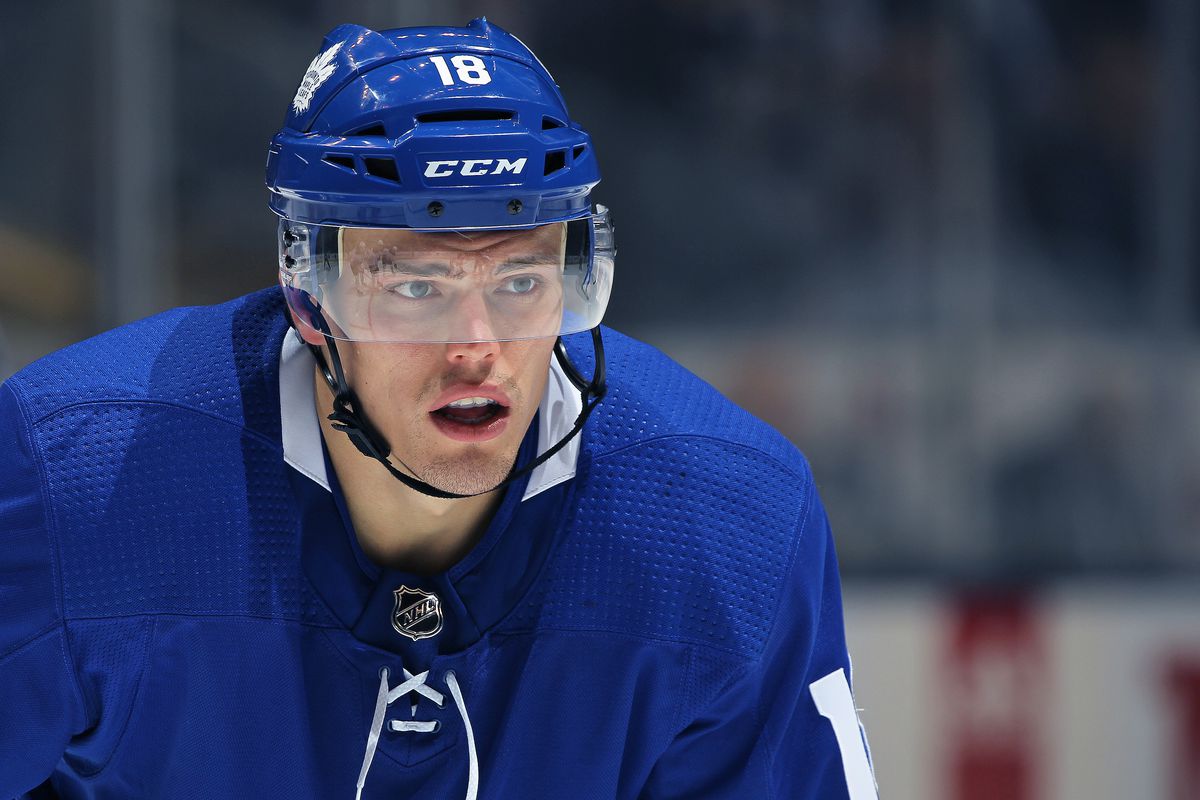The Toronto Maple Leafs announced that they have traded winger Andreas Johnsson to the New Jersey Devils in exchange for winger Joey Anderson.
Before we get into the players, let’s make no mistake here – this is a salary dump. Johnsson is slated to make $3.4M per season for the next three seasons, and it was proving to be too costly for the Leafs.
After trading Andreas Johnsson to NJ, we now show the Toronto #MapleLeafs back under the ceiling with $2,306,467 in projected cap space.
Roster: 20 (11F-7F-2G)
Unsigned RFA's:
F Ilya Mikheyev
F Joseph Anderson
D Travis Dermotthttps://t.co/BPt2vFET34 pic.twitter.com/PGVevQam5c— CapFriendly (@CapFriendly) October 10, 2020
One for one, this trade is a loss for the Leafs. There’s really nothing else to say about the acquisition itself. Anderson is a 22-year-old third-round pick with 13 points in 52 NHL games. He has been decent in the AHL (34 points in 44 games there last season), played in the USDP, and was the USA’s captain at the World Juniors a few years ago. There is some promise here if you want to squint (again, he’s also 22).
Johnsson scored 20 goals and 43 points last season, followed by 21 points in 43 games this season. There are legitimate questions as to whether he can stay healthy as he has had some injury troubles since coming to North America both with the Marlies and the Leafs. But there’s no question that when Johnsson plays, he is a legitimate 40+ point scorer and 20-goal man. The Leafs thought highly enough of him to insert him into Game 5 after not playing for months because his impact is that strong when he’s on his game (he did miss a prime scoring chance in that game, too).
Johnsson’s primary linemates were Auston Matthews and William Nylander last season, and they were going head to head against top lines under Mike Babcock. Alongside Matthews, Johnsson and Matthews had 54CF%, 53GF%, and 51xGF%. They were coming out ahead against good opposition together.
There is no question Johnsson is a good player.
The jury is still out for Anderson. He was played on a depth line as a checker against middling lines with reasonable results.
He only played 18 games last season despite a weak New Jersey roster, bouncing between the NHL and AHL. In college, he benefitted by playing with top offensive players like Clayton Keller. At this point, his ceiling appears to be a bottom-of-the roster NHL forward.
This came down to money, and Johnsson’s money was too rich for the Leafs. Ilya Mikheyev needs a new deal, as does Travis Dermott, and they added TJ Brodie for $5M per season yesterday. This move gives them a little over $13M in projected cap space and they still probably need a 3C, arguably a 4C, and an additional defenseman would be nice – which GM Kyle Dubas has already acknowledged. Paying Dermott and Mikheyev should now still leave the money to do so.
The only other realistic option to move at forward was Alexander Kerfoot. Some will point to the fact that he is a centre by default, although I would argue that is slightly disingenuous – he has not stood out at center and, as was noted last year when they acquired him in the first place, Colorado primarily played him on the wing. There is a reason for that.
Johnsson has a slightly better career points per game and goals per game. His possession numbers are slightly better, and he has had slightly less offensive zone starts overall. When someone tries to convince you Kerfoot is more valuable, don’t be fooled. Johnsson is better across the board and they are the same age.
This is part of the process of paying your stars – good, mid-level guys will get squeezed out. Kadri was last year and now Kapanen and Johnsson this year. At this point, only the Kapanen deal represents an opportunity to get the best player in the move – and that is if the Leafs hit on their draft selection.
Their bottom six has essentially lost Johnsson (or Mikheyev, who would move to the top 6 right now), Kapanen, and likely Clifford at this point. They have added Wayne Simmonds and Travis Boyd. Nick Robertson is also likely. It is tough to say that it is a slam dunk improvement. The defense has improved simply by losing Cody Ceci, let alone replacing Tyson Barrie with TJ Brodie. In a nutshell, that is where we are so far with this offseason. We’ll wait and see what more is left to come.
Joey Anderson Scouting Report
From the 2017 Blackbook:
Much of Anderson’s offensive production going into his draft year was credited to playing a lot of minutes with high-end prospects like Kieffer Bellows and Clayton Keller. Anderson was able to display that he is able to create a decent amount of offense himself, finishing 2nd in scoring with 12 goals and 25 assists in 39 games for the Bulldogs. Anderson uses his vision of the ice to make quick passes and set up some beautiful goals. While Anderson isn’t the biggest player in stature, he has a strong and thick base, which makes him difficult to separate from the puck. He also likes to bring a physical style of play in all areas of the ice. Anderson was a bit of a surprise pick for the USA World Junior team, but displayed good versatility, playing mostly in a checking and penalty-killing role on Team USA’s run to Gold. Anderson certainly has a couple more years in college to continue to develop his game and develop more of a pro build, but his versatility to move up and down in a lineup will give him a shot down the road.
Joey Anderson Statistics
| S | Team | League | GP | G | A | TP | PIM | +/- | POST | GP | G | A | TP | PIM | +/- | |
|---|---|---|---|---|---|---|---|---|---|---|---|---|---|---|---|---|
| 2012-13 | Hill-Murray School | USHS-MN | 12 | 14 | 9 | 23 | 2 | | | Playoffs | 3 | 1 | 3 | 4 | 0 | ||
| 2013-14 | Hill-Murray School | USHS-MN | 25 | 21 | 29 | 50 | 16 | | | Playoffs | 3 | 4 | 2 | 6 | 2 | ||
| Team MPLS Magazine | UMHSEHL | 20 | 13 | 10 | 23 | 6 | | | Playoffs | 3 | 2 | 2 | 4 | 2 | |||
| 2014-15 | USNTDP Juniors | USHL | 35 | 14 | 10 | 24 | 6 | -8 | | | - | ||||||
| U.S. National U17 Team | USDP | 55 | 21 | 21 | 42 | 8 | | | - | ||||||||
| USA U17 | WHC-17 | 6 | 3 | 2 | 5 | 0 | | | - | ||||||||
| 2015-16 | USNTDP Juniors | USHL | 25 | 10 | 10 | 20 | 14 | 14 | | | - | ||||||
| U.S. National U18 Team | USDP | 64 | 27 | 30 | 57 | 20 | | | - | ||||||||
| USA U18 | WJC-18 | 7 | 7 | 2 | 9 | 2 | 12 | | | - | |||||||
| 2016-17 | Univ. of Minnesota-Duluth | NCAA | 39 | 12 | 25 | 37 | 8 | 11 | | | - | ||||||
| USA U20 | WJC-20 | 7 | 0 | 2 | 2 | 0 | 1 | | | - | |||||||
| 2017-18 | Univ. of Minnesota-Duluth | NCAA | 36 | 11 | 16 | 27 | 20 | 14 | | | - | ||||||
| USA U20 “C” | WJC-20 | 7 | 4 | 3 | 7 | 0 | 4 | | | - | |||||||
| 2018-19 | New Jersey Devils | NHL | 34 | 4 | 3 | 7 | 6 | -7 | | | - | ||||||
| Binghamton Devils | AHL | 13 | 2 | 4 | 6 | 5 | -2 | | | - | |||||||
| 2019-20 | New Jersey Devils | NHL | 18 | 4 | 2 | 6 | 2 | 1 | | | - | ||||||
| Binghamton Devils | AHL | 44 | 15 | 19 | 34 | 2 | 0 | | | - |


![Sheldon Keefe on the Maple Leafs’ struggling power play: “[We’ve scored] one out of 11 high-danger chances in tight to the net… We have been in those spots and haven’t converted” Sheldon Keefe, playoff press conference](https://mapleleafshotstove.com/wp-content/uploads/2024/04/keefe-pc-game-3-218x150.jpg)

![Jim Montgomery Post Game, Bruins 4 vs. Leafs 2: “[Marchand] still manages to get under people’s skin, yet he doesn’t cross the line” Jim Montgomery, Boston Bruins post game](https://mapleleafshotstove.com/wp-content/uploads/2024/04/jim-monty-pg-to-218x150.jpg)
























![Sheldon Keefe on the Maple Leafs’ struggling power play: “[We’ve scored] one out of 11 high-danger chances in tight to the net… We have been in those spots and haven’t converted” Sheldon Keefe, playoff press conference](https://mapleleafshotstove.com/wp-content/uploads/2024/04/keefe-pc-game-3-100x70.jpg)



![Jim Montgomery Post Game, Bruins 4 vs. Leafs 2: “[Marchand] still manages to get under people’s skin, yet he doesn’t cross the line” Jim Montgomery, Boston Bruins post game](https://mapleleafshotstove.com/wp-content/uploads/2024/04/jim-monty-pg-to-100x70.jpg)

